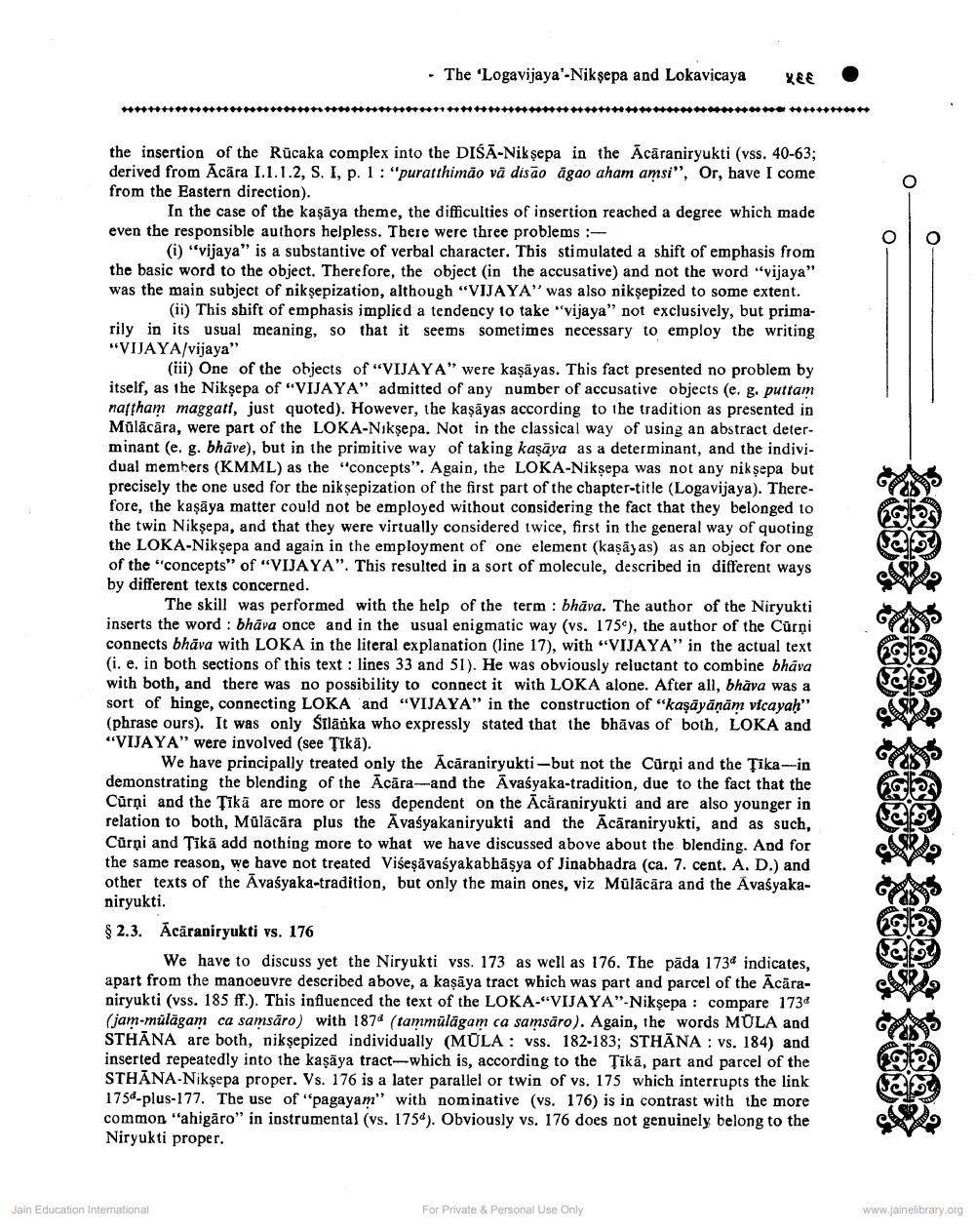Book Title: Logavijaya Niksepa and Lokavicaya Author(s): Bhatt Publisher: Z_Pushkarmuni_Abhinandan_Granth_012012.pdf View full book textPage 4
________________ • The 'Logavijaya'-Nik sepa and Lokavicaya XEE the insertion of the Rūcaka complex into the DISĀ-Niksepa in the Ācāraniryukti (vss. 40-63; derived from Ācāra I.1.1.2, S. I, p. 1: "puratthimão vā disão ágao aham amsi", Or, have I come from the Eastern direction). In the case of the kaşaya theme, the difficulties of insertion reached a degree which made even the responsible authors helpless. There were three problems : (0) "vijaya" is a substantive of verbal character. This stimulated a shift of emphasis from the basic word to the object. Therefore, the object in the accusative) and not the word "vijaya" was the main subject of niksepization, although "VIJAYA" was also nikşepized to some extent. (ii) This shift of emphasis implied a tendency to take "vijaya" not exclusively, but primarily in its usual meaning, so that it seems sometimes necessary to employ the writing "VIJAYA/vijaya" (iii) One of the objects of "VIJAYA" were kaşāyas. This fact presented no problem by itself, as the Niksepa of "VIJAYA" admitted of any number of accusative objects (e. g. puttam nattham maggati, just quoted). However, the kasāyas according to the tradition as presented in Mülācāra, were part of the LOKA-Niksepa. Not in the classical way of using an abstract determinant (e. g. bhāve), but in the primitive way of taking kaşāya as a determinant, and the individual members (KMML) as the "concepts". Again, the LOKA-Niksepa was not any niksepa but precisely the one used for the nikṣepization of the first part of the chapter-title (Logavijaya). Therefore, the kaşāya matter could not be employed without considering the fact that they belonged to the twin Niksepa, and that they were virtually considered twice, first in the general way of quoting the LOKA-Niksepa and again in the employment of one element (kaşayas) as an object for one of the concepts" of "VIJAYA". This resulted in a sort of molecule, described in different ways by different texts concerned. The skill was performed with the help of the term : bhāva. The author of the Niryukti inserts the word : bhäva once and in the usual enigmatic way (vs. 1759), the author of the Cürni connects bhāva with LOKA in the literal explanation (line 17), with "VIJAYA" in the actual text (i. e. in both sections of this text : lines 33 and 51). He was obviously reluctant to combine bhava with both, and there was no possibility to connect it with LOKA alone. After all, bhāva was a sort of hinge, connecting LOKA and “VIJAYA" in the construction of “kaşāyāņām vicayah" (phrase ours). It was only Silānka who expressly stated that the bhāvas of both, LOKA and "VIJAYA" were involved (see Tikā). We have principally treated only the Ācāraniryukti-but not the Cürni and the Tika-in demonstrating the blending of the Acara-and the Avaśyaka-tradition, due to the fact that the Cürni and the Tikā are more or less dependent on the Acăraniryukti and are also younger in relation to both, Mülācāra plus the Āvaśyakaniryukti and the Ācāraniryukti, and as such, Carni and Tīkā add nothing more to what we have discussed above about the blending. And for the same reason, we have not treated Viśeşāvasyakabhāşya of Jinabhadra (ca. 7. cent. A. D.) and other texts of the Avaśyaka-tradition, but only the main ones, viz Mülācāra and the Avaśyakaniryukti. $ 2.3. Ācārapiryukti vs. 176 We have to discuss yet the Niryukti vss. 173 as well as 176. The päda 1734 indicates. apart from the manoeuvre described above, a kaşāya tract which was part and parcel of the Ācāraniryukti (vss. 185 ff.). This influenced the text of the LOKA-“VIJAYA"-Niksepa : compare 173 (jam-mülāgam ca samsāro) with 1874 (tammülāgam ca samsāro). Again, the words MOLA and STHĀNA are both, nikşepized individually (MŪLA: vss. 182-183; STHĀNA : vs. 184) and inserted repeatedly into the kaşaya tract--which is, according to the Tikā, part and parcel of the STHĀNA-Nikṣepa proper. Vs. 176 is a later parallel or twin of vs. 175 which interrupts the link 1750-plus-177. The use of "pagayam" with nominative (vs. 176) is in contrast with the more common "ahigaro" in instrumental (vs. 1754). Obviously vs. 176 does not genuinely belong to the Niryukti proper. Jain Education International For Private & Personal Use Only www.jainelibrary.orgPage Navigation
1 2 3 4 5 6 7 8 9 10
